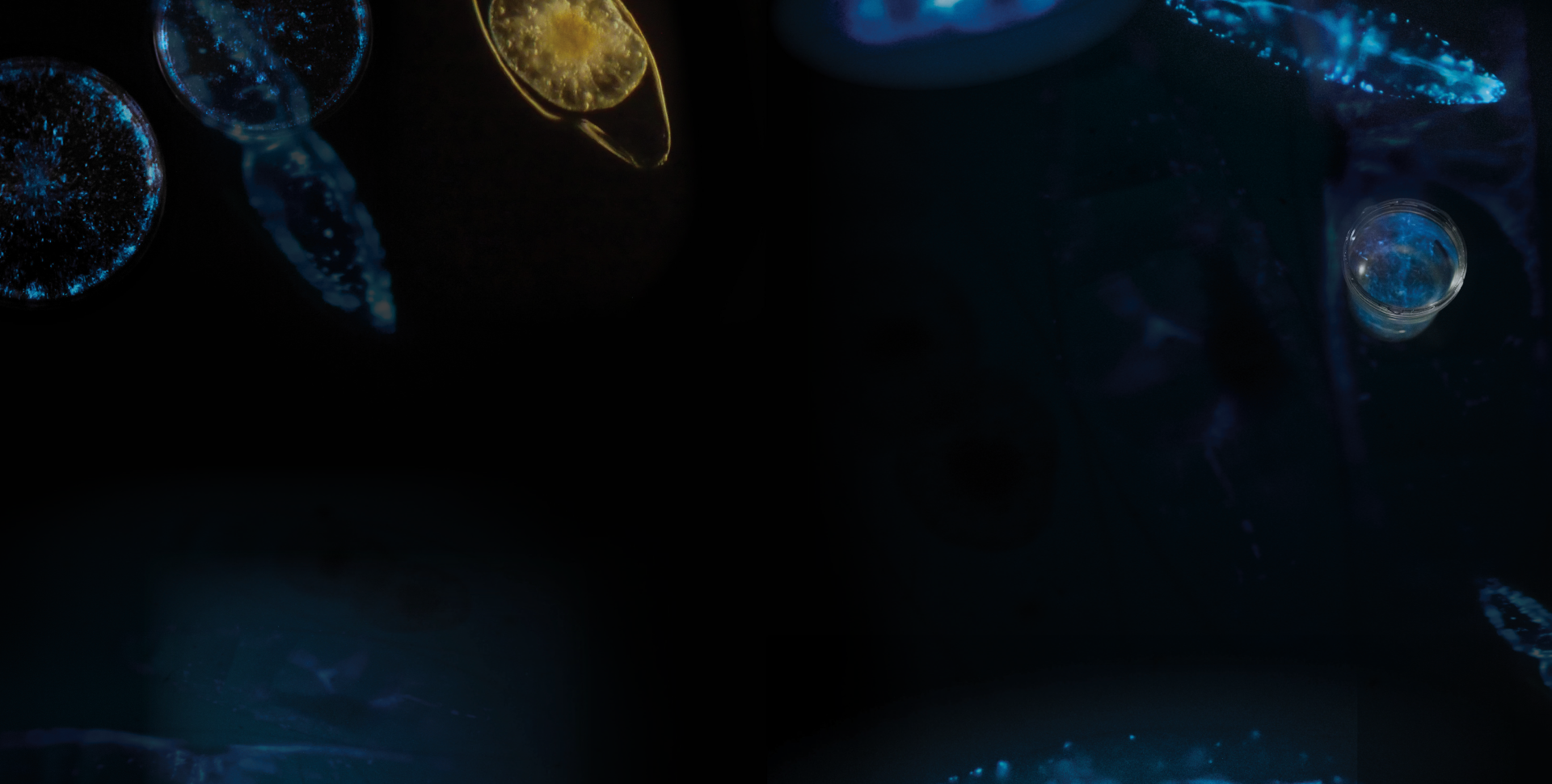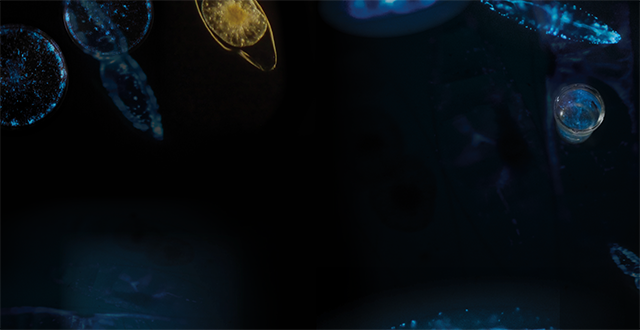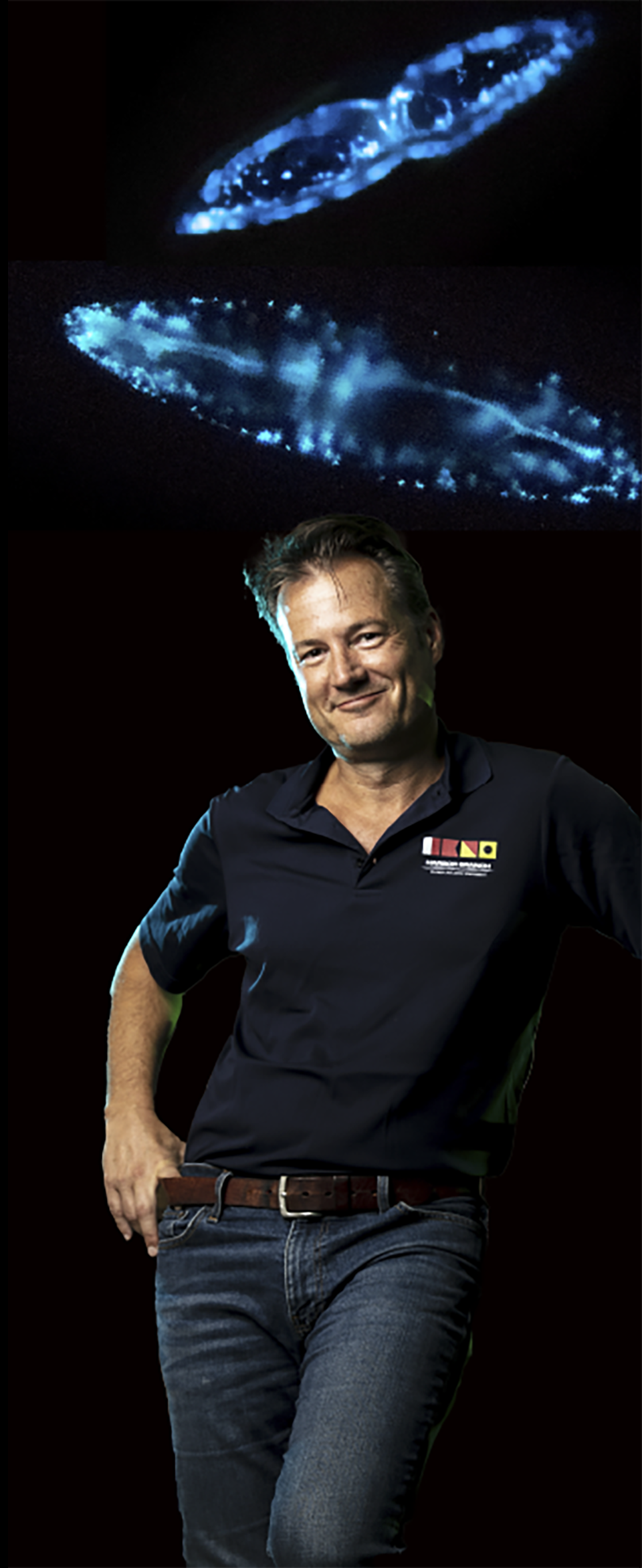

Detecting the Ocean’s
Glowing Creatures
Researchers Awarded $11M Grant From the U.S. Office of Naval Research
By Bethany Augliere
Most of the vast ocean lacks light. Yet at times, the seascape will glow and glitter blue-green, thanks to the light-producing abilities of marine organisms, from tiny single-celled algae up to larger animals like jellyfish and squid. Called bioluminescence, this chemical process is abundant throughout the world’s oceans, and it’s estimated that more than 70 percent of animals in the ocean can produce their own light.
“If you want to understand how biology in the ocean works, you need to understand bioluminescence,” said Mike Twardowski, Ph.D., a research professor at Florida Atlantic University’s Harbor Branch Oceanographic Institute. “Light production by organisms is incredibly common and one of the most important forms of communication in the ocean.”
Now, FAU’s Harbor Branch has landed an $11,179,001 four-year contract from the United States Office of Naval Research (ONR) to study this natural phenomenon using advanced technology.
“For me, the most exciting thing about science is finding out things we never knew before,” said Twardowski, the project’s principal investigator. “In this project, the greatest potential for that is in understanding more about the behavior and the light emissions of zooplankton, because we know quite little about that now.”
Plants and animals emit light for a variety of reasons, including defense, finding or luring food, and communicating with members of their species. For instance, tiny planktonic algae called dinoflagellates emit a bright blue flash when physically disturbed as a defense mechanism to startle predators trying to eat them.
While bioluminescence was well-studied in the 80s and 90s, it was limited by the equipment and available technology, said Jim Sullivan, Harbor Branch director and co-investigator on the project. “It’s been 20 years since intense research has been done on bioluminescence, and we need to look at it with a fresh perspective, fresh eyes and new technology,” he said.

One of the first goals of the project is to develop a compact, state-of-art bathyphotometer, which measures the amount of light emitted directly by animals and algae. These instruments suck seawater through a tube into a dark chamber where turbulence disturbs the animals and algae, causing them to produce light. The scientists can use this flash to determine how many different organisms are in the water, but also measure how much light they produce, and for how long. Additionally, by adding an imaging system to the bathyphotometer, they can identify these flashes for each individual organism to classify the unique signature of each glowing organism, Twardowski said. By deploying the bathyphotometer at different depths, Twardowski and others on the team can get a complete picture of the spatial distribution and abundance of the glowing bioluminescence critters.
Bioluminescence can be detected remotely, above water, with the naked eye or with camera systems. But no current bioluminescence measurement system has the ability to measure the full light emission potential of the organisms in the water column. “When you produce a great new piece of technology, it’s like a window into the ocean that nobody’s ever seen before,” Twardowski said.
Using data from the bathyphotometer, the next step of the project involves modeling. When large animals like whales and dolphins move through patches of bioluminescent organisms, they disturb the water, which then triggers flashes of light. “If we know the spatial variability of the organisms, and we know how much light they emit, and we know for how long they emit it, we can use all that information in a model to predict what that bioluminescence plume will be around the whale, or other objects, and how it would be imaged from above water,” Twardowski said.
The next phase of the project involves “cutting- edge imaging systems that operate above water,” said Twardowski, using drones and other unmanned autonomous vehicles. Different organisms produce different colors of light. For instance, zooplankton often produce light that appears blue-green, whereas dinoflagellates — the world’s primary bioluminescent phytoplankton — produce blue light. One of the imaging systems, therefore, will look at multiple colors in the visible range, which will allow the team to determine more about the kinds of organisms emitting light.
Lastly, in order to interpret all data from the bathyphotomer and the imaging systems, the team will run lab experiments to study the light emissions of the organisms under different conditions. This is the work of newly hired Carina Poulin, a postdoctoral fellow. “What I’m doing in the project is going to help us understand the smaller scale, biological mechanisms behind bioluminescence, to help develop the next generation sensors.”
In general, the project includes a huge team, not only from FAU Harbor Branch, but other institutions as well, including: the University of South Florida, St. Petersburg; University of Florida, Fort Pierce; Scripps Institute of Oceanography, University of California-San Diego; Texas Christian University; Florida International University; and consultants.
“A grant like this — which is extensive — it’s a lot of money over a number of years, will be a cornerstone for the type of Department of Defense sponsored research that we really want to pursue and enhance at FAU and Harbor Branch,” Sullivan said. “It’s just the beginning.” ◆